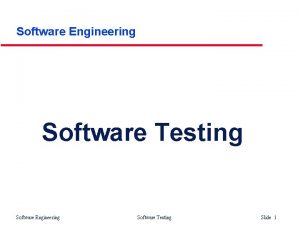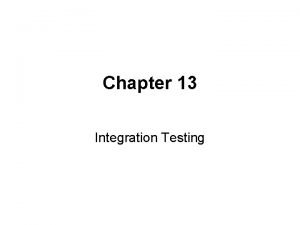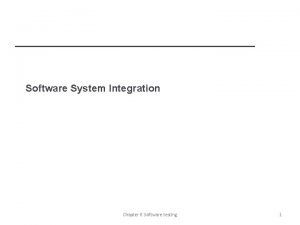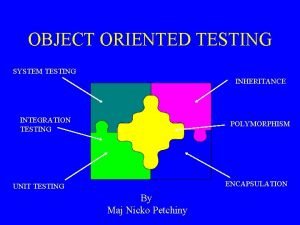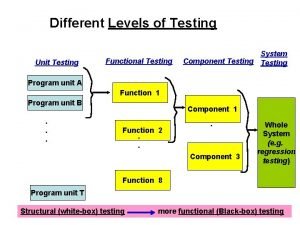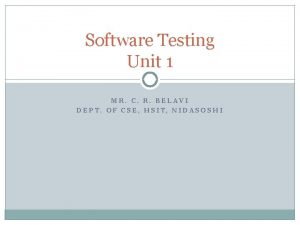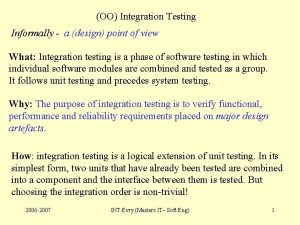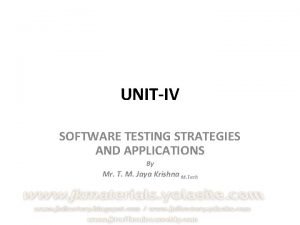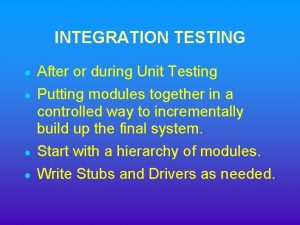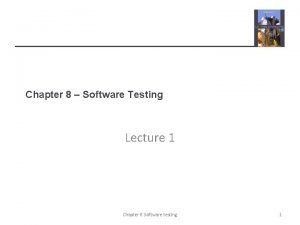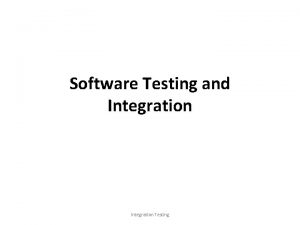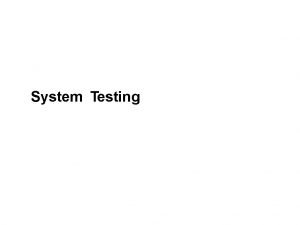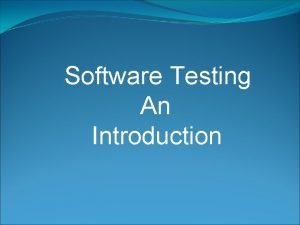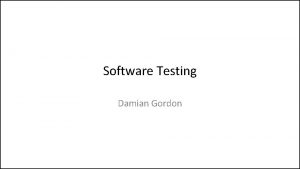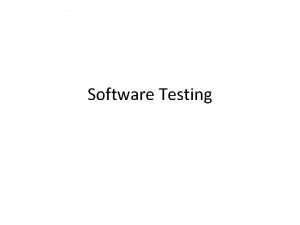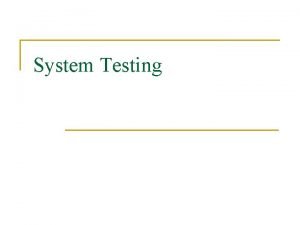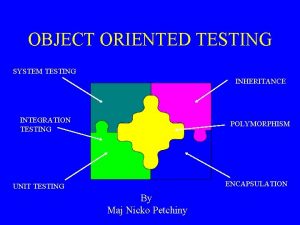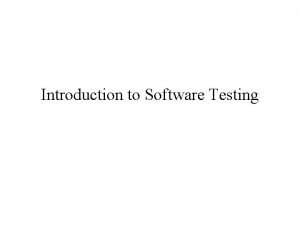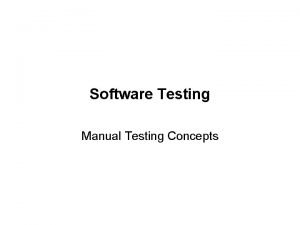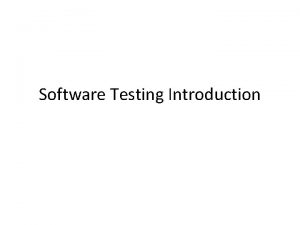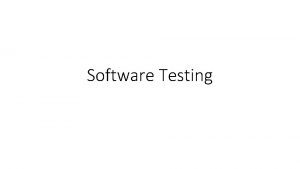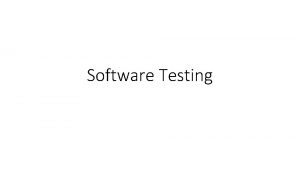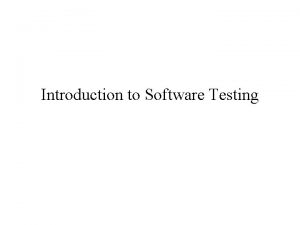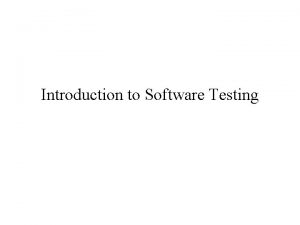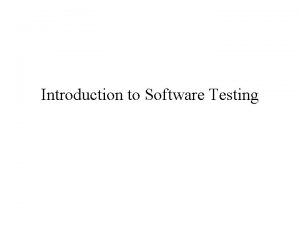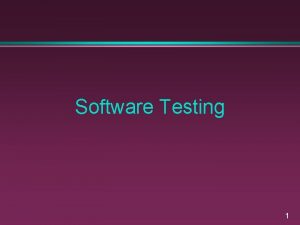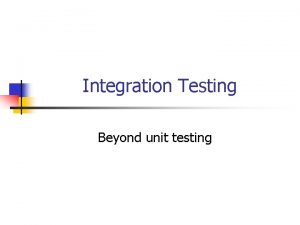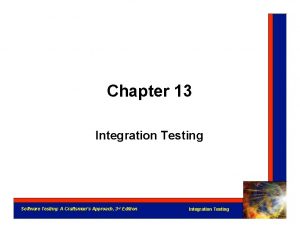Software System Integration Chapter 8 Software testing 1




























- Slides: 28

Software System Integration Chapter 8 Software testing 1

Overview ² What is system integration? ² Integration process description ² Integration testing ² System Integration Checklist Chapter 8 Software testing 2

By the end of this session, you will. . ² Understand the importance and role of system integration ² Understand the system integration process ² Understand what is top-down and bottom-up integration ² Understand what should be done before and during system integration Chapter 8 Software testing 3

What is system integration? ² System integration is the successful putting together of the various components, assemblies, and subsystems of a system and having them work together to perform what the system was intended to do. Requirements Design Coding and unit Integration & Testing test Acceptance Deployment ² Successful system integration results from the proper implementation of project activities Chapter 8 Software testing 4

Integration process planning Chapter 8 Software testing 5

System integration process (1) ² Integration is iterative and progressive, with each level of integration building from and on top of the previous level of integration ² Integration and testing are part of the development process and are used to ensure all the various pieces work together in performing their higher-level functions. Chapter 8 Software testing 6

System integration process (2) Chapter 8 Software testing 7

Interfaces (1) ² Complete Knowledge of all interfaces is essential to any integration effort. ² This includes interfaces between : § § components, assemblies, subsystems, and also the system and other systems it needs to work with. Chapter 8 Software testing 8

Interfaces (2) Chapter 8 Software testing 9

Complete system integration(1) ² Most systems consist of both hardware and software. These two are sometimes looked at as complete systems in and of themselves, but they cannot function independently of each other ² There are two other system elements: people and support systems that are also part of the complete system. ² For a system to be successfully implemented and used, all these elements must be in place and functioning correctly Chapter 8 Software testing 10

Complete system integration(2) Chapter 8 Software testing 11

Integration testing ² Integration testing involves building a system from its components and testing it for problems that arise from component interactions. ² integration testing is nothing but checking the correctness of data flow or interfaces between two or more modules. Chapter 8 Software testing 12

Activity: real time Integration testing ² In Gmail, how to test the integration between “Compose” and “sent items” modules? ? ? Chapter 8 Software testing 13

Integration testing strategies: ² Several different strategies can be used for integration testing. ² Comparison criteria: § fault localization § effort needed (for stubs and drivers) § degree of testing of modules achieved § possibility for parallel development Chapter 8 Software testing 14

Integration testing strategies: ² Initial approach: “Big Bang”: In big bang Integration testing, individual modules of the programs are not integrated until every thing is ready. This approach is seen mostly in inexperienced programmers who rely on 'Run it and see' approach. ² Incremental integration § Top-down integration: In this approach testing is conducted from main module to sub module. if the sub module is not developed a temporary program called STUB is used for simulate the sub module. § Bottom-up integration: In this approach testing is conducted from sub module to main module, if the main module is not developed a temporary program called DRIVERS is used to simulate the main module. Chapter 8 Software testing 15

Big Bang approach ² Non-incremental strategy § Unit test each module in isolation § Integrate as a whole Chapter 8 Software testing 16

Example: Big Bang integration test A test B test D test C test E test A, B, C, D E, F, G test F test Chapter 8 Software. G testing 17

Big Bang approach ² Advantages § Convenient for small systems ² Disadvantages § Integration testing can only begin when all modules are ready § Fault localization difficult § Easy to miss interface faults Chapter 8 Software testing 18

Top-down Integration Algorithm 1. Use Main control module as a test driver and substitute all modules that are directly subordinate to it by stubs. 2. Depending on the integration approach selected (depth first or breadth first), choose a stub and replace it by a real module. 3. Tests are conducted after replacement of a stub by a real module. 4. While there exist stubs in the system, go to step 2(loop) 5. Stop when the whole system structure is built and no stubs remain. Chapter 8 Software testing 19

Example: Top down Integration Chapter 8 Software testing 20

Top-down Integration testing approach ² Advantages § Fault localization easier § Few or no drivers needed § Possibility to obtain an early prototype § Different order of testing/implementation possible § Major design flaws found first • in logic modules on top of the hierarchy ² Disadvantages § Need lot of stubs / mock objects § Potentially reusable modules (in bottom of the hierarchy) can be inadequately tested Chapter 8 Software testing 21

Bottom-up Integration Algorithm 1. Construct drivers for low level modules. 2. Execute and test each driver separately. 3. Remove drivers and combine modules moving upward into clusters that perform a specific software subfunction. When the main module is reached go to 5) 4. Construct a driver per cluster. Go to 2) 5. Stop when the whole system structure is built and no drivers remain. Chapter 8 Software testing 22

Example: Bottom-up Integration Chapter 8 Software testing 23

Bottom-up Integration ² Advantages § § Fault localization easier (than big-bang) No need for stubs / fewer mock objects Logic modules tested thoroughly Testing can be in parallel with implementation ² Disadvantages § Need drivers § High-level modules (that relate to the solution logic) tested in the last (and least) § No concept of early skeletal system Chapter 8 Software testing 24

System integration checklist Before starting 1. Do your test plans include and support integration efforts? 2. Does your development plan allocate adequate time and resources for system integration efforts, including rework time? 3. Are the interfaces between components, assemblies, subsystems, and systems defined in adequate detail? 4. Will hardware be available for testing software during integration? 5. Is there a contingency plan if the schedule slips and if the integration schedule is compressed? 6. Are all elements of the system included in the integration plan? 7. Is all documentation current and available for reference? Chapter 8 Software testing 25

System integration checklist During integration (1) 1. Is there an efficient rework cycle in place to fix problems found during integration testing? 2. Are “fixed” modules or components integrated and retested at all levels of integration up to the level where the problem was found? 3. Is the people element (operators, maintainers, logisticians, trainers, etc. ) being prepared to work with the system when it is deployed? 4. Is the support systems element (logistics, maintenance, training, etc. ) being prepared to support the new system when it is deployed? 5. Are you following an iterative, progressive integration process? 6. Are experienced integrators involved with the integration? Chapter 8 Software testing 26

System integration checklist During integration (2) 7. Are area/subject matter experts involved with the integration? 8. Is adequate time being allowed for integration, testing, rework, reintegration, and retesting? 9. Are all necessary resources being made available for integration? 10. Is adequate testing being performed on integrated units (assemblies, subsystems, elements, system) to ensure that there are no surprises during acceptance testing? 11. Are you updating documentation during rework? 12. Are integration and system test errors being traced back to requirements and design? And if so, are the requirements and design being updated? Chapter 8 Software testing 27

References ² http: //www. stsc. hill. af. mil/resources/tech_docs/gsam 4/chap 14. pdf ² Guide to Software Engineering Body of Knowledge, especially Appendix D: http: //www. swebok. org ² NASA Systems Engineering Handbook: http: //ldcm. gsfc. nasa. gov/library. htm ² Software Engineering Institute: www. sei. cmu. edu ² System Engineering Fundamentals, 2001, Defense Acquisition University, download at: www. dau. mil/pubs/gdbks/sys_eng_fund. asp Chapter 8 Software testing 28
 Defect testing in software engineering
Defect testing in software engineering Call graph based integration in software testing
Call graph based integration in software testing Neighborhood integration testing
Neighborhood integration testing System integration testing checklist
System integration testing checklist Object oriented integration testing
Object oriented integration testing Domain testing in software testing
Domain testing in software testing Motivational overview in software testing
Motivational overview in software testing Data flow testing strategies in software testing
Data flow testing strategies in software testing Globalization testing example
Globalization testing example What is testing
What is testing Control structure testing in software testing
Control structure testing in software testing Decision table testing in software testing
Decision table testing in software testing Decision table testing in software testing
Decision table testing in software testing Extended entry decision table
Extended entry decision table Rigorous testing in software testing
Rigorous testing in software testing Testing blindness in software testing
Testing blindness in software testing Software testing domains
Software testing domains Forward integration and backward integration
Forward integration and backward integration Forward backward integration
Forward backward integration Simultaneous integration and sequential integration
Simultaneous integration and sequential integration Sandwich integration testing
Sandwich integration testing Neighborhood integration testing
Neighborhood integration testing Functional testing vs unit testing
Functional testing vs unit testing Hsit nidasoshi
Hsit nidasoshi Sandwich integration testing
Sandwich integration testing Black box testing
Black box testing Sandwich integration testing
Sandwich integration testing Airflow ci cd
Airflow ci cd Chapter 8 software testing
Chapter 8 software testing
